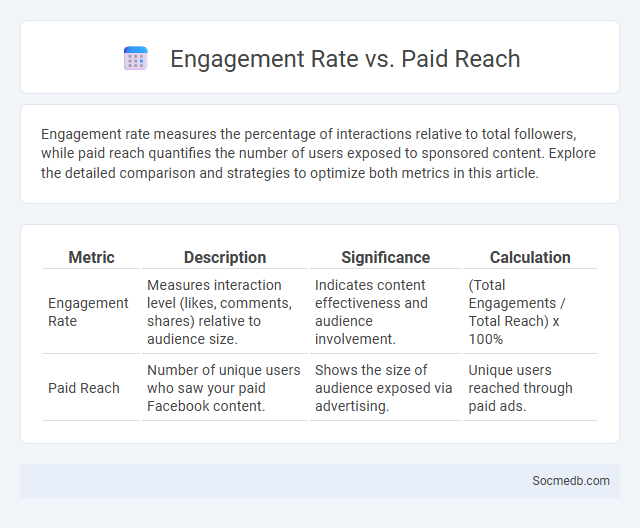
Photo illustration: Engagement Rate vs Paid Reach
Engagement rate measures the percentage of interactions relative to total followers, while paid reach quantifies the number of users exposed to sponsored content. Explore the detailed comparison and strategies to optimize both metrics in this article.
Table of Comparison
| Metric | Description | Significance | Calculation |
|---|---|---|---|
| Engagement Rate | Measures interaction level (likes, comments, shares) relative to audience size. | Indicates content effectiveness and audience involvement. | (Total Engagements / Total Reach) x 100% |
| Paid Reach | Number of unique users who saw your paid Facebook content. | Shows the size of audience exposed via advertising. | Unique users reached through paid ads. |
Understanding Engagement Rate: Definition and Importance
Engagement rate measures the level of interaction your audience has with social media content, including likes, comments, shares, and clicks, relative to your follower count. Tracking this metric provides valuable insights into how well your posts resonate and helps optimize your social media strategy for higher visibility and growth. Understanding engagement rate empowers you to create content that fosters stronger connections and drives meaningful audience participation.
What is Paid Reach? Key Concepts Explained
Paid Reach refers to the number of unique users who see your social media content as a result of paid promotions or advertisements. It differs from organic reach by targeting specific audiences through budgeted campaigns, allowing you to increase visibility beyond your existing followers. Understanding Paid Reach helps optimize ad spend and improve the overall effectiveness of your marketing strategy.
Engagement Rate vs Paid Reach: Core Differences
Engagement rate measures the percentage of interactions--likes, comments, shares--relative to the total audience, reflecting content's organic appeal and user involvement. Paid reach quantifies the number of users exposed to content through advertising efforts, highlighting audience size rather than interaction quality. Analyzing engagement rate versus paid reach helps marketers balance between authentic user connection and controlled exposure for campaign effectiveness.
Calculating Engagement Rate: Metrics and Methods
Calculating engagement rate on social media involves analyzing metrics such as likes, comments, shares, and follower count to measure audience interaction. The most common methods include dividing total engagement by follower count or impressions, then multiplying by 100 to express the rate as a percentage. Accurate engagement rate calculations help marketers assess content effectiveness and optimize strategies for platforms like Instagram, Facebook, and Twitter.
Factors Affecting Engagement Rate on Social Media
Engagement rate on social media is influenced by factors such as content quality, audience relevance, posting frequency, and timing. Visual elements like images and videos increase interaction compared to text-only posts. Your ability to respond promptly to comments and messages also plays a crucial role in boosting engagement and building community trust.
How Paid Reach Influences Overall Engagement
Paid reach amplifies your content visibility by targeting specific demographics, which significantly boosts overall engagement rates on social media platforms. By strategically investing in paid promotions, your posts reach a broader but relevant audience, increasing likes, shares, and comments. This enhanced exposure not only drives more user interaction but also improves organic reach through algorithmic favorability.
Comparing Organic vs Paid Engagement Rates
Organic engagement rates typically reflect genuine interactions from followers who are naturally interested in your content, often resulting in higher trust and long-term loyalty. Paid engagement rates can boost visibility quickly by targeting specific demographics, but may yield lower interaction quality as not all engagements come from genuinely interested users. Understanding the balance between these metrics helps you optimize your social media strategy for both authentic growth and targeted reach.
Strategies to Boost Engagement Rate with Paid Reach
Leveraging targeted ad placements and audience segmentation significantly enhances your paid reach on social media platforms, driving higher engagement rates. Optimizing ad creatives with compelling visuals and clear calls to action encourages interaction and shares among your audience. Utilizing data analytics to refine these strategies ensures that your content resonates effectively, maximizing the return on your paid social media investments.
Measuring Success: Tools for Tracking Engagement and Reach
Measuring success on social media relies on tools like Google Analytics, Hootsuite Insights, and Sprout Social, which track key metrics such as engagement rate, reach, impressions, and follower growth. These platforms provide data-driven insights into audience behavior, content performance, and campaign effectiveness, allowing you to optimize strategy and maximize ROI. Tracking social media analytics consistently helps improve your brand visibility and drive meaningful interactions.
Best Practices for Balancing Engagement Rate and Paid Reach
Maximize your social media strategy by balancing organic engagement and paid reach to increase visibility and interaction. Focus on creating high-quality, relevant content that encourages genuine audience participation while strategically utilizing targeted ads to amplify your message. Monitor analytics closely to optimize budget allocation, ensuring you maintain an effective blend of organic growth and paid promotion for sustained performance.
 socmedb.com
socmedb.com